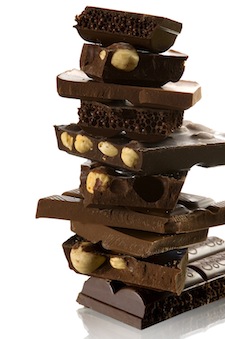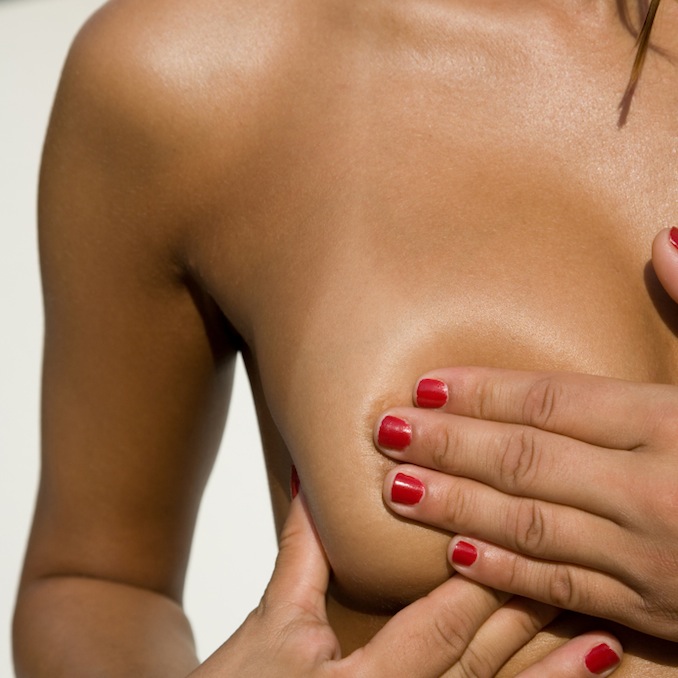It’s not your imagination. From spots to sleepiness, lumpy breasts and cravings, some things ARE your hormones’ fault
1. SPOTS An excess of ‘androgens’ – male hormones – such as testosterone in the second half of your cycle can lead to oilier skin and random pimples. Some women also find that being on a low estrogen Pill can cause them breakouts. What to do Switching to a Pill such as Zoely may help regulate excess testosterone that could be causing the oiliness. If it’s mild and hits only in the second half of your cycle, you can try a pre-emptive strike by applying a product that contains acne-fighting salicylic acid such as Dr Nick Lowe’s Oil Control Day Cream £15.49 the week before your period.
2. MOOD SWINGS About a quarter of women suffer with Pre-Menstrual Syndrome (PMS) – bloating, breast tenderness and moodiness – from rising progesterone in the second half of the cycle (cruelly, it gets worse in our mid-30s). This is normal. But 5-10 per cent of women will get severe, irrational mood swings which signal the more rare Pre-Menstrual Dysphoric Disorder (PMDD) or extreme PMS. The most distressing symptoms of PMDD are mood-related and women affected report becoming a Jekyll and Hyde character in the two weeks before their period and can even get violent. Yet most get misdiagnosed with a psychiatric disorder. What to do Keep a cycle diary, writing down key words about how you feel on each day for 2-3 months to help your GP confirm a diagnosis. You can keep a daily online symptoms diary at pms.org.uk and print it for your doc. If your pre-period moodiness is mild, treatments such as Cyclopret from Bionorica £20.49 contains Agnus Castus, that may help alleviate mild PMS-related irritability, mood swings and cramps.
3. CRAVINGS Although food cravings are not directly associated with hormones, your cycle may still be to blame. In the second half of the cycle many women experience a rise in insulin resistance which can lead to increased blood sugar spikes and cravings for simple carbs such as chocolate and cakes. It’s worsened by living or working under stress that raises adrenaline making cravings worse. What to do Try and avoid excess caffeine or alcohol – sticking to a cup or glass a day – in the two weeks before your period as these cause ‘rebound hypoglycaemia’ (quick drops in blood sugar) and more cravings. Just half an hour of cardiovascular exercise releases enkephalins and endorphins that help blood sugar balance. Taking 200mg a day of chromium (Higher Nature Chromium £4 from highernature.co.uk) and adding a pinch of cinnamon to your breakfast cereal or smoothie are also proven to help chronic sugar-seeking.
4. SLEEPINESS If you’re mainlining sleep pre-period, blame hormonal overdrive as rising progesterone has an anaesthetic affect on the body, relaxing muscle activity. If you suffer from constipation before your period, you can thank progesterone’s relaxing effects on the bowel for this too. Progesterone dampens intestinal muscle contractions that keep you regular so women can become bloated and constipated before their periods. What to do A multivitamin high in B Vitamins and magnesium taken all month can help your body replace the energy stores used up by the hormonal upheaval that takes place in the second half of your cycle. Try Healthy Woman Support £20.87 from naturalhealthpractice.com. For constipation, soaking a tablespoon of whole linseeds or flaxseeds (from the health food shop) overnight swallowed first thing can keep your bowels moving in a healthy way, especially in the two weeks before your period.
5. HAIR THINNING / OVERGROWTH If your hair is looking thinner in the light or it’s receding at the temples or on the scalp, this ‘male pattern’ thinning could be the result of excess testosterone levels. Women with PCOS are more likely to have this kind of hair loss. On the other hand, if you are noticing excessive thick, black hair growing where you wish it wouldn’t, on the chin, sideburns, lower back, tummy, chest or nipples, this too could be a sign of PCOS. Low iron stores and underactive thyroid can manifest as hair loss (thinning outer edges of the brows can especially signal the latter). What to do As soon as you notice a ‘male pattern’ of hair thinning see your doctor. Early treatment is important as it can slow or halt the condition causing the hair loss but it can’t replace hair that is already lost. Talk to your GP about a referral to a specialist PCOS clinic or endocrinologist who can provide treatment for the symptoms you’re most concerned about, including prescribing laser hair removal for excessive hair growth. Ask your doctor for blood tests to check your thyroid hormone and ‘ferritin’ or iron levels and eat plenty of good quality protein such as eggs, lentils and lean meats for healthy hair.
6. FAT (well, some fat) Tummy bloat is one thing and if it’s really associated with your period will be alleviated when you start your bleed. But many people – including GPs – don’t know that excess weight around the tummy is a symptom of PCOS. People with PCOS don’t handle carbohydrates well and might be eating what they have always eaten but find they are suddenly gaining weight for no reason. What to do Lifestyle is key in helping you cope with the symptoms of PCOS. Exercise is essential to helping the body handle carbohydrates and burn off excess calories, as is a diet low in carbohydrates and high in vegetables and quality protein. By getting your Body Mass Index under 30 or shifting about ten per cent of any excess weight other symptoms of PCOS could also improve such as hair loss and pimples. Talk to your doctor.
7. SORE BOOBS Up to 70 per cent of us will experience breast pain, tenderness and even benign lumps at some point. For most, this will relate to normal hormonal changes taking place in the fortnight before your period. The breast glands get swollen and retain fluid as your body prepares itself for a possible pregnancy. As progesterone also encourages the body to retain fluid, if you eat a diet high in salt or caffeine, tenderness and soreness may get worse as breasts retain water at this time. What to do Get any lumps that have remained after your period checked by your doctor immediately. Breast pain and tenderness can also be helped pre-period by wearing an extra supportive underwire bra and by avoiding salt pre-period to lessen any fluid build up in the breasts. If a lump you have found turns out to be a cyst that is getting bigger or is painful your doctor may advise you to have it drained, but if it’s small, doesn’t hurt and isnt getting bigger this is probably not necessary. For monthly breast tenderness and pain, taking Evening Primrose Oil or Starflower Oil has been proven to alleviate symptoms, but you need to take it for around three months to see a difference. Try Efamol Evening Primrose Oil £6.89 from Boots.
EXACTLY WHAT HAPPENS DURING YOUR CYCLE
Week 1: Cycle starts – oestrogen and progesterone levels are low, you’ve got your period.
Week 2: Body preps for ovulation – oestrogen rises as your egg matures and fertility increases. Around day 14 ovulation occurs, women report feeling most like having sex around now.
Week 3: Egg is released (that’s if you’re not on the Pill) – The egg lasts about 24 hours without being fertilized, then starts travelling down the fallopian tubes to the uterus. Progesterone levels increaseand you’re in the ‘luteal’ half of your cycle. If you get PMS it probably starts now…
Week 4: Body preps for period – this will discharge the built up womb lining as estrogen and progesterone levels drop again and you begin a new cycle
RELATED VIDEO What your period says about your health
RELATED VIDEO How your cycle affects your workout
RELATED VIDEO Eating for healthy hormones
Like this article? Sign up to our newsletter to get more articles like this delivered straight to your inbox.























































